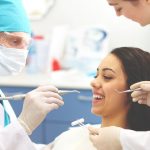Parents often ask if orthodontic treatment (braces, plates or other orthodontics devices) can damage teeth? Modern orthodontic treatment reveals many great opportunities. Unfortunately, it can negatively affect teeth and gums without proper care of the oral cavity, without observing oral hygiene
Wearing the orthodontic devices it is not easy to care for teeth and gums. Even the simplest orthodontic device is a great center for the accumulation of food residues and dental plaque. It is difficult to clean places around the orthodontic device, self-cleaning is disrupted. Removable parts of orthodontic devices (braces, orthodontic rings, tubes, wire, springs, etc.) accumulate food residues and plaque on the teeth and gums edge. If the oral hygiene is not followed carefully, the gums get swelling and redness. Thus, inappropriate oral hygiene leads to the occurrence of dental decay and gum inflammation. Clinically, these diseases are usually observed after removing the orthodontic device.
Children often evade and avoid tooth brushing. Therefore, in order to ensure proper oral hygiene, unified efforts of the orthodontist, dentist, oral hygienist, parents and children are needed. The patient should use a toothbrush and additional oral hygiene products for proper oral hygiene: hygienic interdental flosser, interdental cleaning brush, mouthwash, etc. Patients wearing removable orthodontic devices must have a separate brush to clean them.
Toothbrush cleaning
Patients are advised to use special brushes with 3 rows of bristles – short cut in the middle row and long on the sides. The toothbrush should be soft, with rounded bristles. Teeth should be cleaned with toothbrush after every meal and before bedtime for 2-3 minutes. First, the areas around the braces are cleaned with horizontal movements, then the cheek chewing and inner surfaces of the teeth are cleaned. Entrance surfaces can be cleaned by vertical, sweeping, circular movements; chewing – by horizontal and circular, palatal and glossal – by sweeping movements. It is very important to clean the plaque accumulated near the edge of the gums. The brush bristles are inserted at a 45 degree angle into the palatinal groove, pressed lightly so that the bristles are not bent and clean by vibratory movements, i.e. the ends of the bristles remain in place. If there are no conditions to clean your teeth, you should at least wash your mouth with water.
Interdental cleaning
It is not possible to completely clean plaque from the teeth with toothbrushes. For interdental cleaning, hygienic flosser and interdental brushes are used. When braces are cleaned, the flosser is threaded with a special needle or flosser with a rigid end is used. Cleaning is performed by swinging the tooth surface up and down 4-5 times. The interdental cleaning with flosser is performed once a day. It is better to clean in the evening before brushing, because it is easier to get fluoride from toothpaste into the clean area. Wide interdental areas, teeth under braces are cleaned with interdental brushes of certain thickness with and without brackets.
Mouthwash
Mouthwashes containing fluorine and substances that inhibit plaque formation are recommended for patients wearing orthodontic devices.
You can enjoy healthy teeth and a beautiful smile with proper oral hygiene.









